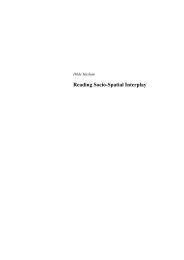CON ⢠TEXT - Arkitektur- og designhøgskolen i Oslo - AHO
CON ⢠TEXT - Arkitektur- og designhøgskolen i Oslo - AHO
CON ⢠TEXT - Arkitektur- og designhøgskolen i Oslo - AHO
- No tags were found...
You also want an ePaper? Increase the reach of your titles
YUMPU automatically turns print PDFs into web optimized ePapers that Google loves.
D E N K U L T U R E L L E S K U L E S E K K E Nunveiling of the processes by the scientist’s ability to debunk. In later texts(Latour 2004; 2005), he changes his stance and claims that the critiqueneeded now is not one of debunking or deconstruction. These roads lead tonothingness. Deconstruction can lead to nothingness because it is a way totear down and annihilate the ‘construct’ and ‘fetishism’, and in the end it onlyserves the researcher. There is a need to focus on ‘scenes’ where the bindingforce is questioning and criticism, the events that can be studied, and that willlead the actors to activate justification of choices (Boltanski and Thévenot2006), which in turn will reveal our point of departure for critique andquestions.In DKS the inclusion of two worlds within one professional practice is asituation where criticism is actively communicated in an effort to establishthe ‘ownership’ of the area. It is not a deconstruction of a phenomenon, butrather a situation of inclusion and of assembling. It is an arena where actorsgather and are regarded as critical participants. Even as the professionalsinvolved are capable of communicating their views and values to the public,the researcher is still needed to give references to something more than thesituation, as another blind spot might be discovered in the more absoluteversion of an Interpretive/Constructivist approach (Groat and Wang 2002).This perspective in its pure pragmatic form, though interesting, is restrictingin its focus on individual interaction as the only basis for meaning. It does notallow for anything beyond the situation, and meaning exists only as situatedmeaning. Everything is constructed within that situation, and nothing newcan be brought to the interpretation by the researcher. The challengeregarding the DKS pr<strong>og</strong>ram is to locate the narratives that are created by thecriticism that is activated. Professionals justify their choices and practice, andsubstantiate their claims through criticism.Bourdieu’s theories have played an important part in Art Education researchin commenting on cultural legitimacy and judgements of taste and status.However, I find that they can to some extent be read as an example of the factposition. I am aware that the Nordic context is quite different from the Frenchcontext. However, I still choose to comment on some of the issues I see. Evenas he provides several useful concepts, such as illusio, doxa, habitus andtypes of capital (Bourdieu 1995; Bourdieu and Wacquant 1995), theimpression left is one of predetermination. As people are born into differentclasses, they have very little say in the matter of capital that they ‘inherit’ —or rather are given access to and, as such, come to possess knowledge of.Moving between the classes — to be given access to know other types ofcapital or values is seen as quite difficult to manage. If you do, you tend toovercompensate by insisting on a strict approach to what constitutes culturalcapital (Bourdieu 1995). Bourdieu tries through his concept of cultural18
















